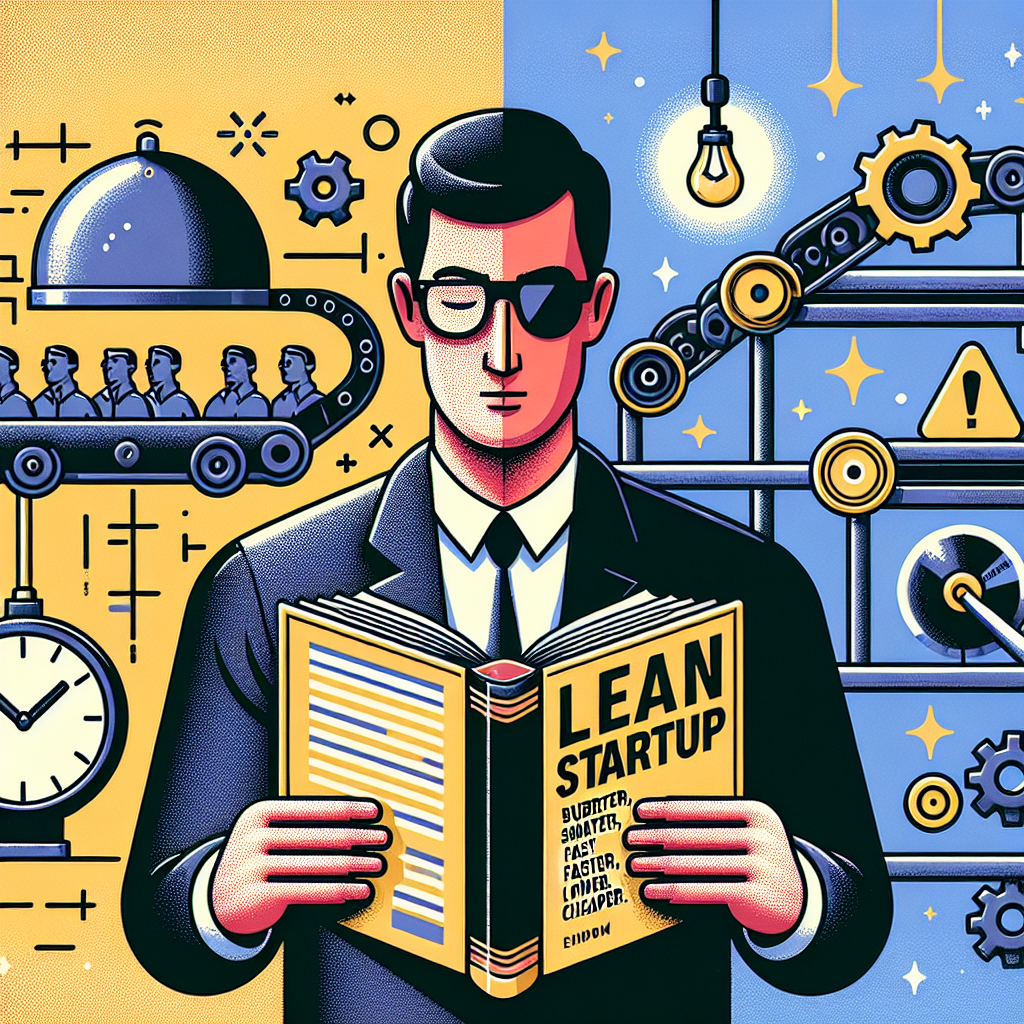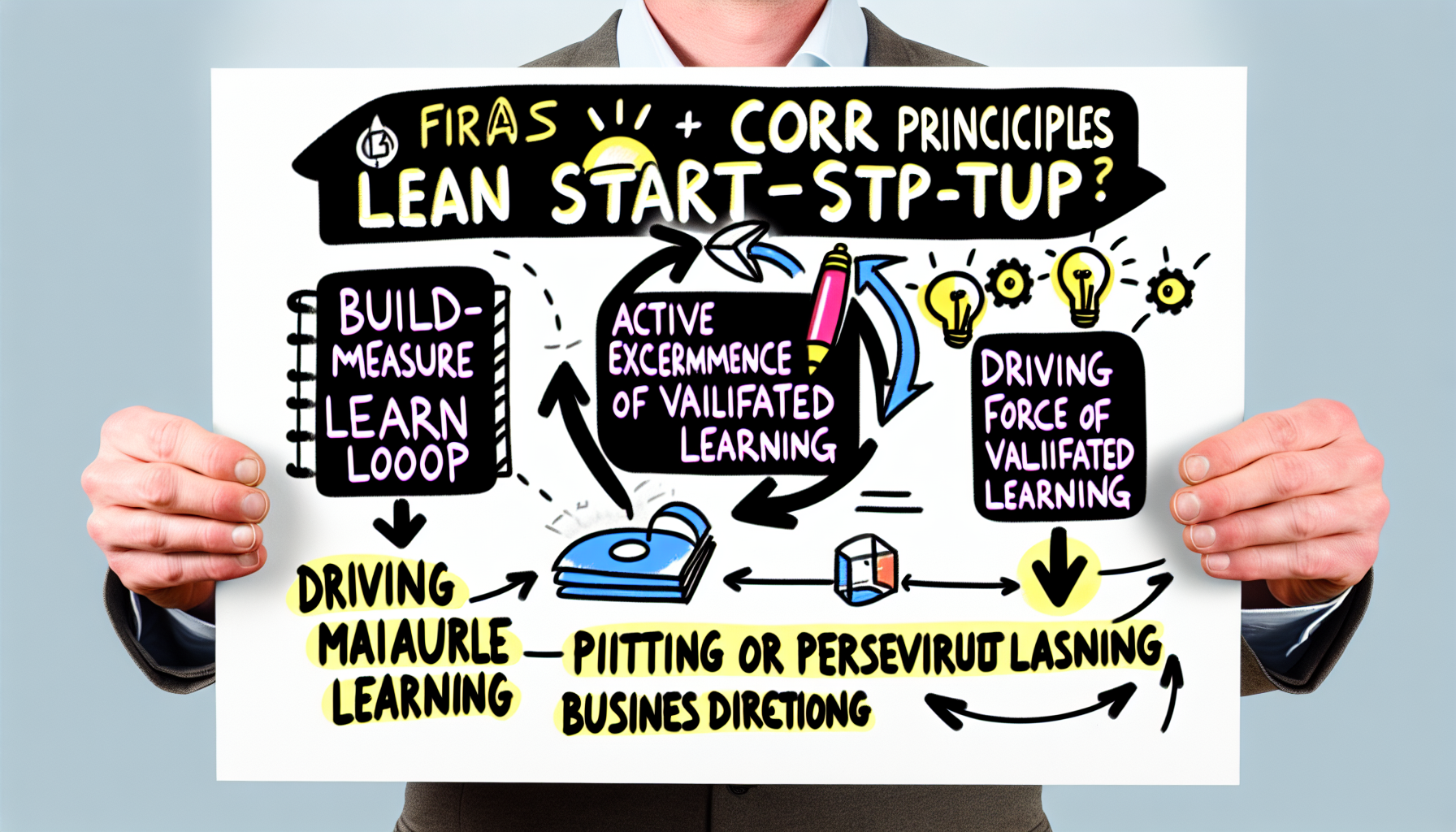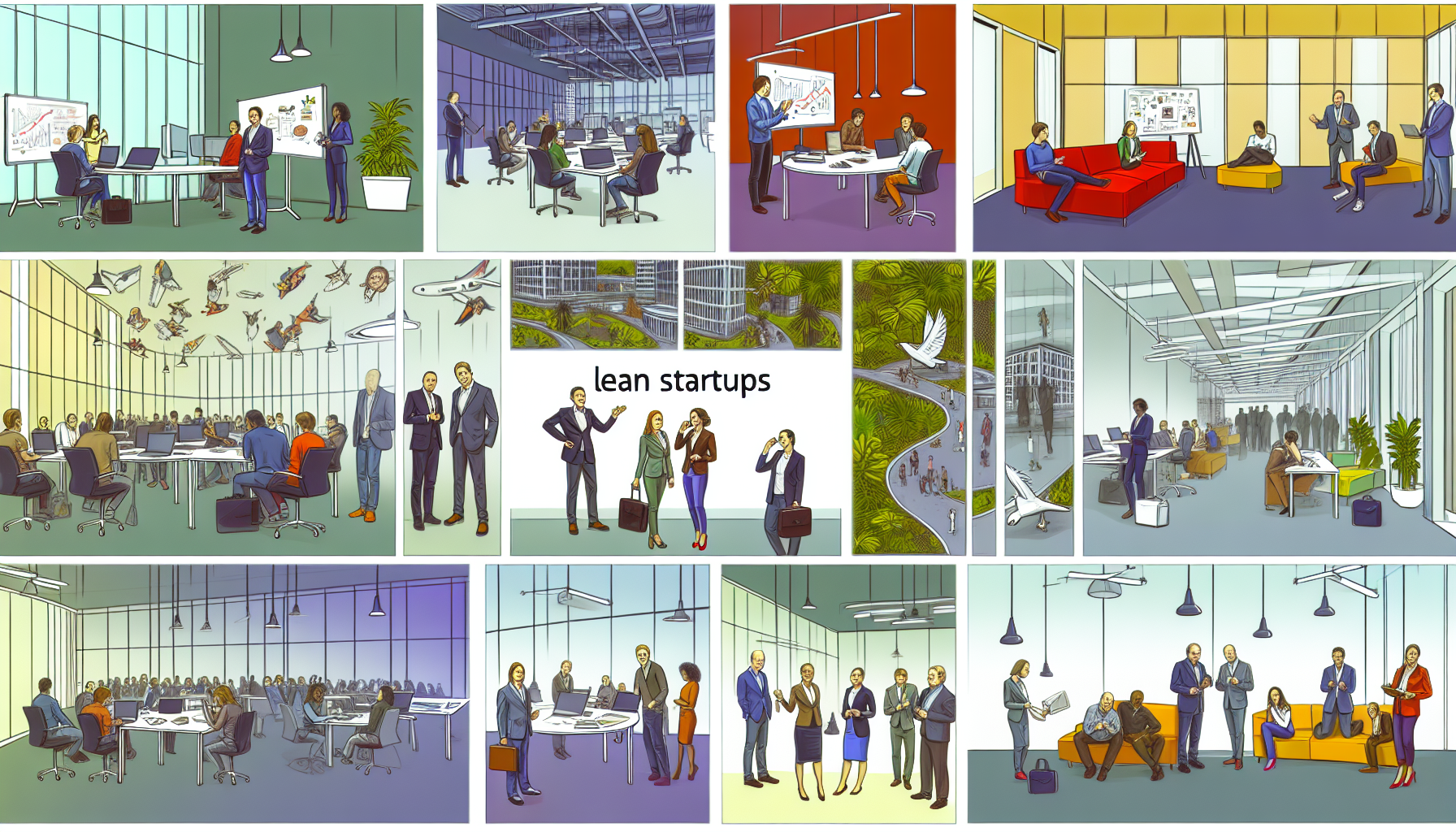Discover the power of Lean Startup methodology and revolutionize your business approach. Build smarter, faster, and cheaper with proven strategies.

The Lean Startup methodology is a systematic approach to developing businesses and products that emphasizes customer feedback, iterative progress, and efficient use of resources. Originating from the combined insights of management, entrepreneurship, and technology, the methodology was popularized by Eric Ries in his book, “The Lean Startup,” which has since become a foundational text in the world of modern entrepreneurship. The core premise of Lean Startup lies in the belief that startups are inherently uncertain, and they must accommodate this uncertainty by continuously learning and adapting to their customers’ needs.
At its core, Lean Startup encourages entrepreneurs to apply lean manufacturing principles—commonly used in production environments—to the process of building and developing new products. This approach emphasizes the importance of rapid experimentation and validated learning, allowing startups to identify viable ideas and pivot quickly based on real feedback. Through these iterative cycles, businesses can minimize waste, both in terms of resources and time, ultimately leading to smarter, faster, and cheaper innovations.
In today’s entrepreneurial landscape, where the pace of change is accelerating, the Lean Startup methodology has gained prominence. It offers a framework that enables startups to thrive amid volatility and uncertainty. The principles of agility and responsiveness are crucial, particularly as consumer preferences evolve rapidly. The Lean Startup methodology encourages entrepreneurs to embrace a culture of experimentation and continuous improvement, which fosters innovation. By integrating new ideas and processes, businesses can remain competitive and relevant in a crowded marketplace.
As we delve deeper into the principles and practices of the Lean Startup methodology, it becomes essential to understand its key components, such as minimum viable products (MVPs), validated learning, and the build-measure-learn feedback loop. These concepts provide a robust framework for navigating the complexities of entrepreneurship and heralding a new era of business development.

The Lean Startup methodology is fundamentally structured around three core principles: Build, Measure, and Learn. These principles serve as a framework that enables entrepreneurs to develop their ideas with greater efficiency, thereby minimizing waste and maximizing learning opportunities. The first step, Build, involves the creation of a Minimum Viable Product (MVP). By focusing on a basic version of the product that allows for early customer feedback, startups can validate their hypotheses without significant resource investment. This iterative approach encourages teams to embrace a ‘fail fast, learn fast’ mindset, fostering innovation.
The second principle, Measure, emphasizes the importance of data collection and analysis in assessing the performance of the MVP. Startups must identify key performance indicators (KPIs) to track and effectively measure the response from early users. This continuous measurement promotes informed decision-making based on real user feedback rather than assumptions. It allows teams to pivot when necessary, adapting their product to meet market demands more accurately.
The final principle, Learn, encapsulates the insights gained from both the Build and Measure stages. By analyzing the data collected regarding user interactions and preferences, startups can discern whether to persevere with their current strategy or pivot to a new one. This learning phase is crucial, as it reinforces the necessity of agility in the startup environment. Through these interconnected principles of Build, Measure, and Learn, lean startups cultivate a culture of continuous improvement. This cycle not only accelerates innovation but also enhances the likelihood of creating products that resonate with the market, ultimately leading to a smarter, faster, and cheaper approach to entrepreneurship. These core principles work in harmony, shaping a resilient and adaptive organizational structure that thrives on feedback and agility.
A Minimum Viable Product (MVP) is a fundamental concept within the lean startup methodology, serving as the initial version of a product with just enough features to satisfy early adopters and validate a business idea. The primary purpose of an MVP is to test assumptions and gather feedback while minimizing development costs and time. By launching a product with essential features, startups can quickly assess market demand and make informed decisions based on real user responses rather than speculation.
Creating an MVP involves identifying the core problem that the product aims to solve and determining the smallest set of features necessary to address that issue. Startups should prioritize functionality that delivers value to the user and facilitates learning about their preferences and needs. This approach allows entrepreneurs to iterate and improve the product based on feedback, refining features that resonate with users while discarding those that do not. It is important to recognize that the MVP is not a final product; rather, it serves as a starting point for further development and enhancement.
Several well-known companies have successfully utilized an MVP strategy to validate their market approach. For instance, Dropbox famously began with a simple explainer video to showcase the core functionality of its file-sharing service before building the full platform. This allowed them to gauge interest and gather feedback from potential users effectively. Similarly, Airbnb started with a basic website to test its rental concept, ultimately leading to significant growth and market domination. These examples illustrate that an effective MVP can provide valuable insights and guide strategic decisions in product development.
In conclusion, understanding the Minimum Viable Product (MVP) is critical for startups aiming to adopt the lean methodology. By focusing on essential features, gathering user feedback, and iterating based on that feedback, startups can ensure that they are building products that truly meet market needs while minimizing resource expenditure.

Market validation is a critical component of the lean startup methodology, serving as the bridge between entrepreneurial ideas and market realities. By engaging real customers early in the development process, businesses can effectively ascertain whether their concepts have the potential to succeed in a competitive environment. This phase not only involves testing initial hypotheses but also collecting valuable insights to refine product offerings and enhance customer satisfaction.
There are several methods entrepreneurs can employ for market validation. One widely used approach is conducting surveys or interviews with potential customers. This technique allows startups to gather direct feedback, understanding the needs and preferences of their target audience. Online tools such as Google Forms or Typeform facilitate easy data collection, enabling startups to analyze customer responses efficiently.
Another effective method for validating ideas is through the creation of minimum viable products (MVPs). An MVP is a simplified version of a product that includes only the essential features required to meet the demands of early adopters. Developing an MVP allows businesses to enter the market swiftly, test their hypotheses, and gather crucial feedback with minimal investment. This iterative process ensures that products are aligned with customer expectations before significant resources are committed to full-scale production.
Additionally, techniques like A/B testing can be employed to evaluate customer responses to different aspects of a product or service. By presenting varying versions of an offering to distinct customer segments, startups can determine which elements resonate most effectively. This data-driven approach equips entrepreneurs with the insights necessary to make informed decisions about product adjustments.
Overall, the role of market validation within the lean startup cycle cannot be overstated. Emphasizing customer feedback and responsiveness allows businesses to refine their ideas effectively, increasing the likelihood of achieving product-market fit. This process ultimately leads to smarter, faster, and more cost-effective development in bringing innovative solutions to market.
Agile development plays a crucial role in the implementation of the lean startup methodology by promoting flexibility and rapid iteration. At its core, agile development is characterized by iterative processes, incremental delivery, and collaborative efforts focused on responding to change rather than adhering strictly to a predefined plan. This aligns seamlessly with lean startup principles, which emphasize validating ideas quickly and adapting based on customer feedback.
One of the primary advantages of incorporating agile techniques into lean startups is the enhancement of responsiveness to market dynamics. Startups often operate in uncertain environments, where consumer preferences may shift unexpectedly. Agile methodologies allow teams to pivot quickly, ensuring that the product being developed is in line with what customers actually want, rather than what the founders initially conceived. This responsiveness can be a significant advantage in gaining traction within competitive landscapes.
Moreover, agile development encourages continuous improvement through well-defined sprints and regular feedback loops. This approach not only cultivates a culture of learning within the team but also ensures that the product evolves according to validated insights. Frequent iterations can reduce the risk of developing features that do not meet customer needs, thus adhering to the lean startup principle of maximizing value while minimizing waste.
Additionally, agile techniques facilitate enhanced collaboration among team members, fostering an environment conducive to innovation. By breaking down silos and promoting cross-functional teams, startups can leverage diverse perspectives, ultimately leading to more robust product development. This collaborative spirit aligns well with the lean startup approach, where collective problem-solving is essential in overcoming challenges and driving growth.
In conclusion, the symbiotic relationship between agile development and lean startup methodologies is evident. By integrating agile techniques, startups can better navigate uncertainty, enhance their responsiveness to consumer needs, and foster a culture of continuous improvement, all of which are vital for achieving success in today’s fast-paced business environment.
Growth hacking is a term that has gained substantial traction in the startup ecosystem, referring to innovative, cost-effective strategies aimed at achieving rapid growth. For startups operating under the lean startup methodology, growth hacking serves as a vital complement, allowing these enterprises to maximize their resources while achieving significant market penetration. Unlike traditional marketing approaches that may require substantial budgets and time commitments, growth hacking emphasizes creativity, analytical thinking, and a deep understanding of customer behavior.
One of the core principles of growth hacking is the focus on rapid experimentation across various marketing channels to identify scalable strategies. This often includes techniques like viral marketing, social media exploitation, and leveraging data analytics to refine messaging. Startups can utilize the concept of “minimum viable products” (MVPs) to gather user feedback, adjust their offerings quickly, and position themselves favorably in the marketplace. By continuously iterating based on customer insight, startups can minimize waste and optimize resource allocation, which aligns seamlessly with lean methodologies.
In practice, growth hacking can take many forms. For instance, startups might implement referral programs that incentivize users to promote their products, effectively utilizing their existing customer base as a marketing tool. Additionally, A/B testing becomes crucial for unveiling what resonates with target audiences. Data-driven decisions are the hallmark of successful growth hacking, ensuring that resources are spent efficiently and yield maximum return on investment.
Moreover, collaborations with influencers or embracing content marketing can significantly enhance visibility, enabling startups to reach a wider audience without the heavy costs typically associated with conventional advertising. Such methods encourage organic growth, which is both sustainable and advantageous for early-stage companies.
By harnessing growth hacking strategies, startups can navigate their journey with an agile mindset, ultimately propelling themselves toward success in today’s competitive environment.

Continuous improvement is a foundational principle of the lean startup methodology, focusing on constant refinement and enhancement of processes, products, and services. Startups that prioritize this approach create an environment conducive to experimentation and learning, which is essential for their adaptability in rapidly changing markets. By cultivating a culture rooted in innovation, these organizations can respond effectively to customer feedback and market demands, ensuring they remain competitive and relevant.
The cycle of continuous improvement begins with the development of a minimum viable product (MVP), allowing startups to test their hypotheses in real-world conditions. Through iterative processes, entrepreneurs collect valuable data on consumer preferences and behaviors, leading to informed adjustments. This practice not only aids in optimizing the product itself but also strengthens the overall business strategy. The ability to pivot, based on empirical evidence gathered during continuous improvement efforts, is a hallmark of successful startups.
Furthermore, integrating continuous improvement into the organizational culture is vital. Encouraging all team members to participate in the feedback loop fosters a sense of ownership and accountability. Regularly scheduled review sessions, brainstorming meetings, and open forums can facilitate the sharing of ideas and observations, which drives innovation from multiple perspectives. By employing tools such as Kaizen and Agile methodologies, startups can enhance their operational efficiency and foster collaboration.
In conclusion, continuous improvement is not just a tactical approach but a strategic mindset that enables startups to thrive in dynamic environments. This emphasis on experimentation and adaptation empowers businesses to evolve alongside their customers, ultimately driving long-term success and sustainability. Startups that embrace this principle will likely find themselves better equipped to navigate the challenges of their respective markets.
Building a culture that aligns with the lean startup methodology is essential for fostering innovation and growth within an organization. The foundation of a lean startup culture is determined by its core values: experimentation, collaboration, and resilience. Cultivating these values requires deliberate strategies and actions from leaders and team members alike.
Firstly, promoting a mindset of experimentation involves encouraging employees to take risks and explore new ideas without the fear of failure. This can be achieved through regular brainstorming sessions, hackathons, and innovation workshops, where team members can propose, test, and iterate on their ideas. Offering incentives for successful innovations, as well as for learning experiences stemming from failures, further reinforces this experimental mindset. Organizations should communicate that failures are stepping stones to success, allowing individuals to feel safe in their pursuit of creativity.
Collaboration is another critical component of a lean startup culture. To foster teamwork, organizations can implement cross-functional teams that bring together diverse skill sets and perspectives. This collaboration can be enhanced by utilizing collaborative tools and platforms that facilitate communication and streamline the sharing of ideas and resources. Encouraging open dialogue among team members, along with regular feedback loops, can significantly improve team dynamics and enhance problem-solving capabilities.
Resilience is vital for teams to successfully navigate the uncertainties inherent in the startup environment. Leaders should model resilience by embracing challenges as learning opportunities and supporting team members through setbacks. Providing resources such as mentoring, professional development, or wellness programs can empower individuals to cultivate their ability to recover from obstacles and setbacks.
In summary, creating a lean startup culture hinges on embedding the principles of experimentation, collaboration, and resilience into the organization’s fabric. By actively promoting these values, a business can nurture an environment where innovation thrives, ultimately leading to smarter, faster, and cheaper growth strategies.
In the realm of the lean startup methodology, defining key performance indicators (KPIs) is crucial for gauging progress and success. The essence of lean startups lies in their ability to pivot based on real-time data, and effective measurement is at the heart of this practice. KPIs serve as measurable values that demonstrate how effectively a company is achieving its key business objectives. Selecting the right metrics allows businesses to track performance accurately and make informed, data-driven decisions.
One popular set of KPIs for lean startups includes metrics such as customer acquisition cost (CAC), lifetime value (LTV) of customers, and conversion rates. Customer acquisition cost refers to the total expenses incurred to attract a new customer, whereas lifetime value represents the total revenue a business can expect from a single customer throughout their relationship. These metrics work together to help assess whether the cost of acquiring more customers is justified by the revenue they generate.
Another important metric is the retention rate, illustrating how successful a startup is at keeping its customers. A high retention rate often indicates that a startup is meeting customer needs effectively and can prevent wasted resources on customer acquisition. Furthermore, tracking engagement metrics, such as user activity and feedback, offers valuable insights into product reception and user satisfaction. Understanding these engagement levels can inform necessary adjustments to product offerings or marketing strategies.
Data-driven decision-making is an integral part of measuring success in the lean startup methodology. Gathering and analyzing data allows entrepreneurs to develop hypotheses and test them iteratively, optimizing their strategies based on outcomes. By focusing on metrics that truly matter, startups not only assess their current status but also lay a solid foundation for sustainable growth. In conclusion, leveraging the right KPIs is essential for evaluating the effectiveness of initiatives and steering the business toward long-term success.

The lean startup methodology has been successfully adopted by numerous companies across various industries, providing valuable insights into how businesses can innovate and grow effectively. Among these notable examples, Airbnb stands out as a particularly illustrative case. Founded in 2008, Airbnb initially struggled to gain traction. The founders employed the lean startup principles by developing a minimal viable product (MVP), which consisted of renting out their apartment during a design conference. This initial experiment not only validated the concept but also enabled them to gather feedback to refine their approach. As a result, Airbnb went from a struggling startup to a multi-billion-dollar global enterprise, emphasizing the importance of rapid iteration and customer feedback.
Another compelling case study is Dropbox, which launched in 2007. The founders opted for a different approach by creating a simple video that showcased the app’s functionality. By doing so, they gathered thousands of sign-ups even before developing the product completely. This strategy allowed Dropbox to measure demand effectively and iterate on their features based on user interest. Ultimately, this lean approach led to the platform’s rapid growth, showcasing how preliminary testing can validate ideas without extensive upfront investment.
In the technology sector, Zappos provides an additional example of lean startup principles in action. The initial focus was to test the hypothesis of online shoe sales without holding inventory. The founder would take pictures of shoes from local stores, list them on the website, and only purchase the shoes once a customer placed an order. This model proved successful and allowed Zappos to scale quickly, ultimately leading to its acquisition by Amazon in 2009. Each of these companies utilized the lean startup methodology to navigate challenges effectively, illustrating that even unconventional strategies can yield remarkable outcomes when grounded in consumer insights and iterative development.
The Lean Startup methodology offers a framework oriented towards minimizing waste and maximizing efficiency. However, startups embracing this approach often encounter several common challenges that can impede their progress. Identifying these hurdles is the first step toward effectively addressing them and ensuring the success of the lean process.
One of the prominent challenges startups face is the difficulty in accurately validating their ideas. Entrepreneurs may become attached to their concepts, leading to resistance when it comes to customer feedback. To overcome this, it is essential to cultivate a mindset open to learning. Entrepreneurs should actively engage with potential customers through interviews and surveys to gain genuine insights into their needs. Implementing the “Build-Measure-Learn” feedback loop encourages a systematic approach to refining product ideas based on real-world input.
Another challenge is maintaining focus on key metrics amid the myriad of data available. Startups can easily become overwhelmed by information, which may distract them from critical performance indicators. To counter this, businesses should establish a set of core objectives and relevant metrics that are aligned with their overall vision. Utilizing tools such as dashboards or KPI trackers can help streamline data analysis, allowing teams to focus on outcomes that truly reflect progress toward their goals.
Lastly, resource constraints such as time and funding can limit a startup’s ability to fully implement lean practices. Startups should prioritize their resources effectively by utilizing Minimum Viable Products (MVPs) to test hypotheses before committing significant investments. This approach not only ensures a more prudent allocation of resources but also enhances learning outcomes and informs future iterations of the product.
Adopting the Lean Startup methodology may present various challenges; however, by actively engaging with customers, maintaining focus on key metrics, and optimizing resource allocation, startups can successfully navigate these obstacles. This proactive problem-solving approach lays a robust foundation for sustainable growth and innovation.

As the landscape of entrepreneurship continues to evolve, the Lean Startup methodology remains a pivotal framework for innovation. Emerging trends suggest a shift towards greater integration of advanced technologies, which will reshape how startups implement lean strategies. One key trend is the increasing reliance on artificial intelligence (AI) and machine learning to augment decision-making. Startups that utilize AI can rapidly analyze market data, identify customer preferences, and optimize product features in real time, thus enhancing their lean operations.
Moreover, the proliferation of remote work and digital collaboration tools is poised to influence lean startup practices. The flexibility offered by these tools allows for more diverse talent pools, enabling startups to iterate on ideas quickly without being constrained by geographical limitations. This accessibility can lead to more agile teams capable of responding promptly to market changes, a core tenet of the Lean Startup approach.
Another anticipated change is the increasing importance of sustainability and social responsibility within lean practices. Entrepreneurs are likely to prioritize eco-friendly processes and community impact as integral aspects of their business models. This trend not only aligns with consumer demand for ethical practices but also encourages startups to innovate in ways that reduce waste and enhance efficiency.
Furthermore, the integration of agile methodologies with the Lean Startup framework is becoming more pronounced. This blend fosters an iterative process that enables startups to pivot swiftly in response to feedback and emerging industry trends. As a result, entrepreneurs will be better positioned to navigate uncertainties in a volatile market landscape.
In conclusion, the future of the Lean Startup methodology appears to be filled with dynamic shifts influenced by technology, remote collaboration, sustainability, and agile practices. These trends present exciting opportunities for entrepreneurs to refine their strategies and achieve greater innovation while maintaining lean principles.
As the business landscape continues to evolve, entrepreneurs must adapt to thrive in an increasingly competitive environment. The Lean Startup methodology offers profound insights and strategies for efficiently developing products and services while minimizing waste. By focusing on core principles such as rapid experimentation, customer feedback, and iterative design, startups can significantly enhance their chances of success. This approach encourages a mindset that values flexibility and learning, enabling businesses to pivot in response to market demands.
One of the fundamental tenets of the Lean Startup model is the concept of validated learning. Through rigorous testing of hypotheses, entrepreneurs can gather actionable insights to inform their decisions. This proactive approach not only allows for quicker adjustments but also empowers startups to allocate resources more effectively. By embracing these principles, businesses can build smarter solutions that align closely with customer needs, thus positioning themselves for long-term success.
Moreover, the Lean Startup methodology fosters a culture of innovation and resilience. Entrepreneurs who adopt these practices are better equipped to navigate uncertainty and challenges. They are encouraged to embrace failure as a learning opportunity, thereby refining their strategies continually. This adaptive mindset not only aids in developing superior products but also cultivates a loyal customer base that appreciates the responsiveness of the business.
In conclusion, the adoption of Lean Startup principles is imperative for entrepreneurs seeking to build smarter, faster, and more cost-effective businesses. By prioritizing customer involvement, leveraging data-driven insights, and fostering a culture of experimentation, startups can optimize their operations and significantly increase their chances of enduring success in a dynamic marketplace. Embracing these methodologies, therefore, is not just advantageous; it is essential for thriving in today’s entrepreneurial landscape.
Find Scholarships Offered by Countries Worldwide for Your Academic Goals.
Chose where you want to study, and we will let you know with more updates.